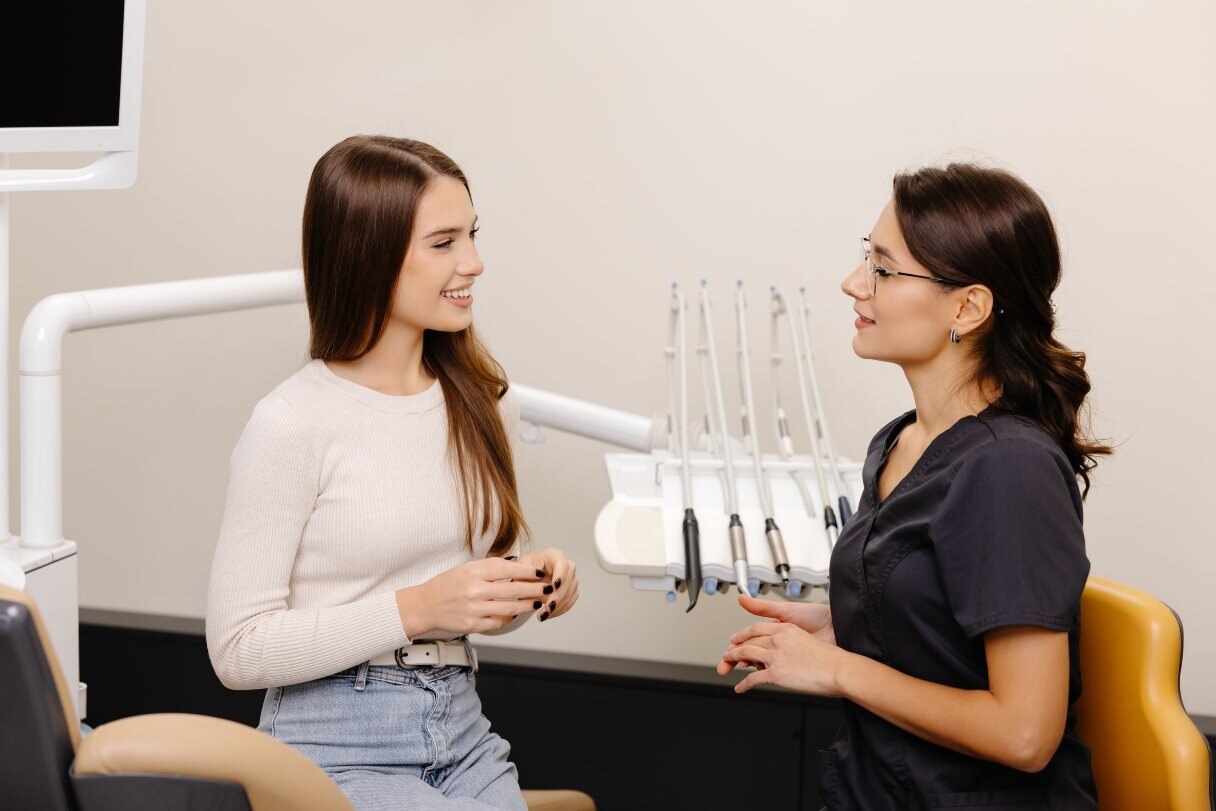KPIs for Dental Practices: From Productivity to Conversions
Key performance indicators are specific to a dental practice. Choose the KPIs that your dental office needs most and monitor their progress and associated data to improve your levels of productivity and financial success.
By Elizabeth Weiss
Digital Writer
Posted Oct 17, 2025 - 7 min read

Key Takeaways
- Track essential dental KPIs like production, collections, patient retention and case acceptance to help identify strengths and address areas needing improvement for better practice performance.
- Monitor patient experience and team metrics such as satisfaction, online reviews and staff turnover to help enhance patient loyalty and create a positive workplace environment.
- Focus on personalized financial and operational strategies to streamline workflows, increase efficiency and align KPIs with your practice’s unique goals for sustained growth and patient care.
Key performance indicators (KPIs) for dental practices are measurable elements that help you track whether your practice is running smoothly and meeting its goals — or if adjustments are needed. While financial KPIs can deliver data insights into the success and efficiency of your dental office, you may want to measure a range of relevant dental KPIs that align with your unique practice objectives.
These indicators might cover various aspects of your practice’s performance, including growth, patient base, profitability, efficiency and overall health. To set achievable and meaningful dental KPIs, it’s important to conduct an objective and comprehensive business evaluation. Some dentists take on this task themselves, while others enlist the help of consultants for guidance.
With so many potential KPIs to consider, it can be helpful to start by focusing on the most impactful metrics for your practice’s financial health and daily operations. Below, we outline key financial, operational, clinical and patient-centered indicators that dental practices commonly track to boost efficiency, profitability and patient satisfaction.
Financial KPIs for Dental Practices
One place dental practices can start is with a manageable number of KPIs to track data that makes sense for their practice, particularly when it is related to dental revenue cycle management. Each dental office has its own priorities for growth, but if you maintain a dental KPI spreadsheet or dental KPI dashboard that highlights relevant dental KPIs, you can assess them regularly to understand where your practice stands.
- Production. Production is the big-picture KPI for dental practices that measures productivity and identifies inefficiencies as well as the total value of services performed. Through this indicator, you can identify scheduling gaps, inefficiencies or production per employee.1 This revenue-based KPI can be measured through how productive your practice is per hour or per visit, as well as per patient.
- Collections. The percentage of actual payments a dental office collects from the fees charged for all types of oral health services sits ideally at 98% to indicate financial health.2 Using financing options can help minimize collections problems or slow payments from patients, particularly when they incur out-of-pocket costs or do not have dental insurance.
- Accounts receivable. Working to reduce the average number of days it takes to collect billing payments can interfere with team efficiency and profitability. By monitoring this KPI for dental practices, you may be able to recognize where and when work is being done and can save time managing accounts receivable, especially when short-staffed.
- Overhead costs. The positive income generated by your practice is diminished by operational expenses, which ideally are 63% or less of your total income.2 If this number is larger than the desired percentage, your KPI is indicating that it’s time to examine expenses and reduce costs where possible.
- Fee-for-service vs. dental insurance. If your practice offers fee-for-service dentistry and accepts dental insurance, too, the ratio between the two options affects your practice. In the fee-for-service model, patients pay directly for treatment without relying solely on insurance. This approach is associated with high-quality care and longer-lasting results. Its straightforward billing process also helps patients bypass insurance limitations.3
- Lab fees. Not all dental labs are created equal in materials, final product or costs. When you conduct an annual fee analysis for your dental office, consider costs charged by your dental lab along with the costs of your dental supplies, equipment and employee benefits. This KPI may indicate the need to raise fees somewhere along the line or renegotiate fees with vendors and suppliers.2 You may even want to consider switching labs.
- Net production per provider. A healthy breakdown of activity in dental practice management is when the dentist generates 75% of production and the dental hygienist generates 25%. Areas of importance include KPIs such as treatment acceptance, pre-booking of hygiene appointments, ongoing care and dentistry that needs to be redone (e.g., a poorly fitted mouthguard or a crown that comes loose).2
Operational and Clinical KPIs for Dentists to Consider
Evaluating how patients behave within your dental practice can be a valuable tool that can provide insight into the effectiveness of your preventive care efforts and the success of patient retention.
- Patient retention rate. Your patient base is critical to dental practice success. The KPI is to maintain the number of existing patients who return regularly.2
- New patient numbers. The number of new patients coming to your dental office every month has an ideal increase rate of 10% to 15% every year.2
- Case acceptance rate. When patients come to your dental office, an important KPI is whether they accept your proposed treatment plan to tend to their oral health needs. A good goal is at least a 75% to 80% patient acceptance rate.2 Accessible financing options can help with this KPI and support practice efficiency.
- Hygiene reappointment rate. Tracking hygiene reappointment rates is a KPI that helps evaluate preventive care engagement and patient retention among active patients.1 You may wish to recommend a professional teeth cleaning every six months for maintaining good oral hygiene.
- Chair utilization rate. A high percentage of scheduled dental chair time occupied by patients can indicate efficient scheduling. Underutilization may point to potential revenue loss.4
- No-show or cancellation rate. The last thing any dentist wants is gaps in the schedule, but a no-show or cancellation rate above 5% is a sign that this dental practice’s KPI might need work.2
Patient Experience and Dental Team Key Performance Indicators
From small tasks to big tasks, your dental team’s daily performance can greatly impact the patient experience. This combination may create important key performance indicators for your dental practice that let you know how well you’re doing with engagement, patient satisfaction and the respect and happiness of your staff.
- Patient satisfaction. Dental patients find satisfaction in various places, whether that’s the ease of digital communication, management of their dental anxiety or accessible cost estimates and financing.5 Measuring this KPI isn’t always easy, but creating personalized patient experiences built on empathy and convenience may improve patient satisfaction because of loyalty, trust and financial options.
- Online reviews and ratings. Some patients may not be shy about voicing praise or complaints on Google, Yelp or social media channels like TikTok, Instagram, Facebook, X and their counterparts. By monitoring and responding to online reviews and ratings, you can create a dental KPI that captures patients’ authentic feelings about what you’re doing right and where things could improve. You can also spin the message through a well-established social media presence.
- Staff turnover. Low staff turnover can signal a healthy workplace. When patients see the same faces, and you don’t need to regularly hire new staff, your KPI may reflect a low dental staff turnover. A focus on a team environment and providing opportunities for growth can help you win this KPI.
Dental KPIs to Measure: Positive Financing Experiences
Dental KPI tracking can be an important part of dental practice management and may help identify opportunities for growth and address inefficiencies. It also allows for informed dental management decisions, whatever your field of dentistry. While pediatric dental practices might be focused on new-patient acquisitions, dentists who regularly perform tooth restorations may look closely at dental lab costs. Every practice has its own needs, goals and KPIs.
With streamlined financing options that are easy to use, like the CareCredit credit card, health and wellness practices may see improvement in their most relevant KPIs. These can include less time spent on accounts receivable (get payment within two business days), increased conversions (easier for new patients to immediately accept treatment) and expansion of treatment from individuals to families (existing patients have an ongoing financial resource for dental care). A seamless dental patient payment experience can be the difference between “yes” and “no” and help positively impact the key performance indicators of your dental practice.
Dental Practice KPIs You Can Use
Dental practice KPIs can provide essential insights that may help your practice track performance, guide strategic decisions and ensure long-term growth. By focusing on the right mix of financial and operational metrics, practices can identify strengths, address weaknesses and better align with their goals. A thoughtful KPI strategy can help empower dental offices to create a positive experience for staff and patients alike.
Learn More: Download our "Strategies for Long-Term Practice Growth"
A Dental Patient Financing Solution for Your Practice
Want to help more patients move forward with the dental care they want or need? Consider offering the CareCredit credit card as a financing solution. CareCredit allows patients to pay for out-of-pocket dental care costs over time while helping enhance the payments process for your practice.
When you accept CareCredit, patients can see if they prequalify with no impact to their credit score, and those who apply, if approved, can take advantage of special financing on qualifying purchases.* Additionally, you will be paid directly within two business days.
Learn more about the CareCredit credit card as a dental patient financing solution or start the provider enrollment process by filling out this form.
Author Bio
Elizabeth Weiss is a freelance writer and editor with more than 20 years of experience in content development for dentistry, orthodontics and cosmetic dermatology. She focuses on making healthcare topics accessible to readers and contributes to many fields, from family and estate law to industrial services and landscape design.
Healthcare payment and financing solution
The CareCredit health and wellness credit card helps improve the payment experience for patients and clients, and your financial performance.
Get StartedReady to help more patients and clients get the care they want and need?
Get StartedReady to help more patients and clients get the care they want and need?
Get Started*Subject to credit approval.
The information, opinions and recommendations expressed in the article are for informational purposes only. Information has been obtained from sources generally believed to be reliable. However, because of the possibility of human or mechanical error by our sources, or any other, Synchrony and any of its affiliates, including CareCredit, (collectively, “Synchrony”) does not provide any warranty as to the accuracy, adequacy or completeness of any information for its intended purpose or any results obtained from the use of such information. The data presented in the article was current as of the time of writing. Please consult with your individual advisors with respect to any information presented.
© 2025 Synchrony Bank.
Sources:
1 “Measure dental practice success with these six KPIs,” California Dental Association. August 20, 2025. Retrieved from: https://www.cda.org/newsroom/leadership-and-practice-ownership/measure-dental-practice-success-with-these-six-kpis/
2 “Measuring success,” American Dental Association. Accessed October 1, 2025. Retrieved from: https://www.ada.org/resources/practice/practice-management/measuring-success20160428t155202
3 Zervas, Steven. “Understanding fee-for-service dentistry: Benefits and considerations for patients,” Village Dental. April 23, 2025. Retrieved from: https://www.villagedentaldtc.com/fee-for-service-dentistry-benefits-and-considerations/
4 “23 essential dental KPIs every practice must track,” Teero. January 16, 2025. Retrieved from: https://www.teero.com/blog/dental-kpis
5 “Improving the patient experience — why it matters,” Experian Health. February 20, 2025. Retrieved from: https://www.experian.com/blogs/healthcare/improving-the-patient-experience-why-it-matters/




